Communication Networks and Performance of Four New Delhi City Parks
Abstract
:1. Introduction
2. Materials and Methods
2.1. Methodology
2.1.1. Data Collection
2.1.2. Data Analysis
2.2. Case Study
Data Collection and Analysis
3. Results
4. Discussion
5. Conclusions
Acknowledgments
Author Contributions
Conflicts of Interest
Appendix A
| Personal Information |
| 1. Name |
| 2. Occupation |
| 3. Place of stay |
| Respondent’s Involvement in the Park |
| 4. Are you satisfied with the greenery in this park? |
| (i) very satisfied |
| (ii) satisfied |
| (iii) not very satisfied |
| (iv) dissatisfied |
| 5. What are the problems faced by this park? |
| 6. How do you think you can overcome these problems? |
| 7. What improvements do you want to see in this park? |
| 8. Have you noticed any changes in the park over time? |
| Important Contacts |
| 9. Whom do you report/share issues regarding the park? |
| 10. How frequently you meet? |
| 11. Who is the most important authority to whom you report regarding the park? |
| 12. With whom you don’t want /don’t like to share issues regarding the park? |
| Other Contacts |
| 13. Regarding matters of the park, do you interact with other people outside the park? |
| 14. How frequently do you meet? |
References
- Nagendra, H. Nature in the City: Bengaluru in the Past, Present and Future; Oxford University Press: New Delhi, India, 2016. [Google Scholar]
- Loures, L.; Costa, L. Urban parks as a driver for urban sustainability—Case studies from Oporto, Portugal. Interdiscipl. Soc. Hum. Sci. 2016, 5, 576. [Google Scholar]
- Vailshery, L.S.; Jaganmohan, M.; Nagendra, H. Effect of street trees on microclimate and air pollution in a tropical city. Urban For. Urban Green. 2013, 12, 408–415. [Google Scholar] [CrossRef]
- Selmi, W.; Weber, C.; Rivière, E.; Blond, N.; Mehdi, L.; Nowak, D. Air pollution removal by trees in public green spaces in Strasbourg city, France. Urban For. Urban Green. 2016, 17, 192–201. [Google Scholar] [CrossRef]
- Stoffberg, G.H.; van Rooyen, M.W.; van der Linde, M.J.; Groeneveld, H.T. Carbon sequestration estimates of indigenous street trees in the City of Tshwane, South Africa. Urban For. Urban Green. 2010, 9, 9–14. [Google Scholar] [CrossRef]
- Solecki, W.D.; Rosenzweig, C.; Parshall, L.; Pope, G.; Clark, M.; Cox, J.; Wiencke, M. Mitigation of the heat island effect in urban New Jersey. Glob. Environ. Chang. Part B 2005, 6, 39–49. [Google Scholar] [CrossRef]
- Fu, P.; Weng, Q. Responses of urban heat island in Atlanta to different land-use scenarios. Theor. Appl. Climatol. 2017. Available online: https://doi.org/10.1007/s00704-017-2160-3 (accessed on 29 August 2017). [CrossRef]
- Angold, P.G.; Sadler, J.P.; Hill, M.O.; Pullin, A.; Rushton, S.; Austin, K.; Small, E.; Wood, B.; Wadsworth, R.; Sanderson, R.; et al. Biodiversity in urban habitat patches. Sci. Total Environ. 2006, 360, 196–204. [Google Scholar] [CrossRef] [PubMed]
- Norton, B.A.; Evans, K.L.; Warren, P.H. Urban Biodiversity and Landscape Ecology: Patterns, Processes and Planning. Curr. Landsc. Ecol. Rep. 2016, 1, 178–192. [Google Scholar] [CrossRef]
- Anderson, L.M.; Cordell, H.K. Residential property values improved by landscaping with trees. South. J. Appl. For. 1985, 9, 162–166. [Google Scholar]
- Czembrowski, P.; Kronenberg, J. Hedonic pricing and different urban green space types and sizes: Insights into the discussion on valuing ecosystem services. Landsc. Urban Plan. 2016, 146, 11–19. [Google Scholar] [CrossRef]
- Shuifa, K.E.; Wagner, J.E.; Zhou, L.; Yali, W.; Yan, Z. The Situations and Potentials of Forest Carbon Sinks and Employment Creation from Afforestation in China 1. Int. For. Rev. 2010, 12, 247–255. [Google Scholar] [CrossRef]
- Roy, S.; Dutta, S.; Hoque, M.M. Urban forestry and urban greening for sustainable urban development—A case of Dhaka north city corporation area (Zone-1). J. Bangladesh Agric. Univ. 2017, 14, 167–176. [Google Scholar] [CrossRef]
- Paul, S.; Nagendra, H. Factors Influencing Perceptions and Use of Urban Nature: Surveys of Park Visitors in Delhi. Land 2017, 6, 27. [Google Scholar] [CrossRef]
- Thierfelder, H.; Kabisch, N. Viewpoint Berlin: Strategic urban development in Berlin–Challenges for future urban green space development. Environ. Sci. Policy 2016, 62, 120–122. [Google Scholar] [CrossRef]
- Mattijssen, T.J.M.; van der Jagt, A.P.N.; Buijs, A.E.; Elands, B.H.M.; Erlwein, S.; Lafortezza, R. The long-term prospects of citizens managing urban green space: From place making to place-keeping? Urban For. Urban Green. 2017, 26, 78–84. [Google Scholar] [CrossRef]
- Tucker, P.; Gilliland, J.; Irwin, J.D. Splashpads, swings, and shade: Parents’ preferences for neighbourhood parks. Can. J. Public Health. 2007, 98, 198–202. [Google Scholar] [PubMed]
- Stewart, O.T.; Moudon, A.V.; Fesinmeyer, M.D.; Zhou, C.; Saelens, B.E. The association between park visitation and physical activity measured with accelerometer, GPS, and travel diary. Health. Place 2016, 38, 82–88. [Google Scholar] [CrossRef] [PubMed]
- Lloyd, K.; Burden, J.; Kiewa, J. Young Girls and Urban Parks: Planning for Transition through Adolescence. J. Park Recreat. Adm. 2008, 26, 21–38. Available online: http://js.sagamorepub.com/jpra/article/view/1311 (accessed on 29 August 2017).
- Schroeder, H.W. Preferred features of urban parks and forests. J. Arboric. 1982, 8, 317–322. [Google Scholar]
- Nicholls, S. Measuring the accessibility and equity of public parks: A case study using GIS. Manag. Leis. 2001, 6, 201–219. [Google Scholar] [CrossRef]
- Wong, K.K.; Domroes, M. The visual quality of urban park scenes of Kowloon Park, Hong Kong: Likeability, affective appraisal, and cross-cultural perspectives. Environ. Plan. B 2005, 32, 617–632. [Google Scholar] [CrossRef]
- Hamilton, J.A.; Crompton, J.L.; More, T.A. Identifying the dimensions of service quality in a park context. J. Environ. Manag. 1991, 32, 211–220. [Google Scholar] [CrossRef]
- Michael, L. Good governance for terrestrial protected areas: A framework, principles and performance outcomes. J. Environ. Manag. 2010, 91, 754–766. [Google Scholar]
- Budruk, M.; Manning, R. Indicators and standards of quality at an urban-proximate park: Litter and graffiti at Boston Harbor Islands National Recreation Area. J. Park Recreat. Adm. 2006, 24, 1–23. [Google Scholar]
- Ammons, D.N.; Coe, C.; Lombardo, M. Performance-Comparison Projects in Local Government: Participants’ Perspectives. Public Adm. Rev. 2001, 61, 100–110. [Google Scholar] [CrossRef]
- Chan, C.S.; Marafa, L.M.; Van Den Bosch, C.C.K. Changing perspectives in urban park management: A longitudinal study of Hong Kong. Manag. Sport Leis. 2015, 20, 56–76. [Google Scholar] [CrossRef]
- Fletcher, D.; Fletcher, H. Manageable Predictors of Park visitor satisfaction: Maintenance and Personnel. J. Park Recreat. Adm. 2003, 21, 1. [Google Scholar]
- Swindell, D.; Kelly, J.M. Linking citizen satisfaction data to performance measures: A preliminary evaluation. Public Perform. Manag. 2000, 24, 30–52. [Google Scholar] [CrossRef]
- Wasserman, S.; Faust, K. Social Network Analysis: Methods and Applications; Cambridge University Press: Cambridge, UK; New York, NY, USA, 1994; Volume 8. [Google Scholar]
- Sandström, A.; Carlsson, L. The performance of policy networks: The relation between network structure and network performance. Policy Stud. J. 2008, 36, 497–524. [Google Scholar] [CrossRef]
- Bodin, Ö.; Crona, B.I. The role of social networks in natural resource governance: What relational patterns make a difference? Glob. Environ. Chang. 2009, 19, 366–374. [Google Scholar] [CrossRef]
- Crona, B.; Bodin, Ö. Power asymmetries in small-scale fisheries: A barrier to governance transformability. Ecol. Soc. 2010, 15, 32. [Google Scholar] [CrossRef]
- Dee, L.E.; Allesina, S.; Bonn, A.; Eklöf, A.; Gaines, S.D.; Hines, J.; Thompson, R.M. Operationalizing network theory for ecosystem service assessments. Trends Eecol. Evol. 2017, 32, 118–130. [Google Scholar] [CrossRef] [PubMed]
- Tichy, N.M.; Tushman, M.L.; Fombrun, C. Social network analysis for organizations. Acad. Manag. Rev. 1979, 4, 507–519. [Google Scholar]
- Sparrowe, R.T.; Liden, R.C.; Wayne, S.J.; Kraimer, M.L. Social networks and the performance of individuals and groups. Acad. Manag. J. 2001, 44, 316–325. [Google Scholar] [CrossRef]
- Chan, C.; Liebowitz, J. The synergy of social network analysis and knowledge mapping: A case study. Int. J. Manag. Decis. Mak. 2006, 7, 1. [Google Scholar] [CrossRef]
- Scott, J.; Tallia, A.; Crosson, J.C.; Orzano, A.J.; Stroebel, C.; DiCicco-Bloom, B.; Crabtree, B. Social network analysis as an analytic tool for interaction patterns in primary care practices. Ann. Fam. Med. 2005, 3, 443–448. [Google Scholar] [CrossRef] [PubMed]
- Borgatti, S.P.; Everett, M.G.; Freeman, L.C. Ucinet 6 for Windows: Software for Social Network Analysis; Analytic Technologies: Harvard, MA, USA, 2002; Available online: http://pages.uoregon.edu/vburris/hc431/Ucinet_Guide.pdf (accessed on 29 August 2017).
- Valentini, R.; Jordán, F. CoSBiLab Graph: The network analysis module of CoSBiLab. Environ. Model. Softw. 2010, 25, 886–888. [Google Scholar] [CrossRef]
- Fussmann, G.F.; Heber, G. Food web complexity and chaotic population dynamics. Ecol. Lett. 2002, 5, 394–401. [Google Scholar] [CrossRef]
- Harary, F. Status and contrastatus. Sociometry 1959, 22, 23–43. [Google Scholar] [CrossRef]
- Freeman, L.C. Centrality in social networks conceptual clarification. Soc. Netw. 1978, 1, 215–239. [Google Scholar] [CrossRef]
- Economic Survey of Delhi, 2014–2015. Available online: http://www.delhi.gov.in/wps/wcm/connect/DoIT_Planning/planning/economic+survey+of+dehli/economic+survey+of+delhi+2014+-+2015 (accessed on 22 April 2016).
- Buch, M. Lutyens’ New Delhi—Yesterday, today and tomorrow. India Int. Cent. Q. 2003, 30, 29–40. [Google Scholar]
- Chandramouli, C.; General, R. Census of India 2011. In Provisional Population Totals; Office of the Registrar General & Census Commissioner: New Delhi, India, 2011. [Google Scholar]
- Krishen, P. Trees of Delhi: A Field Guide; Penguin Books India Ltd.: Delhi, India, 2006. [Google Scholar]
- Sharma, J.P. The British treatment of historic gardens in the Indian subcontinent: The transformation of Delhi’s Nawab Safdarjung’s Tomb complex from a Funerary garden into a public park. Gard. Hist. 2007, 35, 210–228. [Google Scholar]
- Biernacki, P.; Waldorf, D. Snowball sampling: Problems and techniques of chain referral sampling. Sociol. Methods Res. 1981, 10, 141–163. [Google Scholar] [CrossRef]
- Zuo, X.; Hua, H.; Dong, Z.; Hao, C. Environmental Performance Index at the Provincial Level for China 2006–2011. Ecol. Indic. 2017, 75, 48–56. [Google Scholar] [CrossRef]
- Cressie, N. Statistics for Spatial Data; John Wiley Sons: New York, NY, USA, 2015. [Google Scholar]
- Diener, E.D.; Emmons, R.A.; Larsen, R.J.; Griffin, S. The satisfaction with life scale. J. Pers. Assess. 1985, 49, 71–75. [Google Scholar] [CrossRef] [PubMed]
- Taris, T.W.; Schreurs, P.J. Well-being and organizational performance: An organizational-level test of the happy-productive worker hypothesis. Work Stress 2009, 23, 120–136. [Google Scholar] [CrossRef]
- Rad, A.; Hossein, Y.M. A study of relationship between managers' leadership style and employees’ job satisfaction. Leadersh. Health Serv. 2006, 19, 11–28. [Google Scholar]
- Morgan, R.M.; Hunt, S.D. The commitment-trust theory of relationship marketing. J. Mark. 1994, 58, 20–38. [Google Scholar] [CrossRef]
- Franco, L.M.; Bennett, S.; Kanfer, R. Health sector reform and public sector health worker motivation: A conceptual framework. Soc. Sci. Med. 2002, 54, 1255–1266. [Google Scholar] [CrossRef]
- Times of India. Available online: http://timesofindia.indiatimes.com/city/delhi/Lodhi-Garden-decks-up-for-80th-birthday/articleshow/51749253.cms (accessed on 12 June 2017).
- Nadler, D.A.; Tushman, M.L. Beyond the charismatic leader: Leadership and organizational change. Calif. Manag. Rev. 1990, 32, 77–97. [Google Scholar] [CrossRef]
- LeMay, N.V.; Ellis, A. Evaluating leadership development and organizational performance. In Handbook of Leadership Development Evaluation; Wiley: Hoboken, NJ, USA, 2006; pp. 228–260. [Google Scholar]
- Hoppe, B.; Reinelt, C. Social network analysis and the evaluation of leadership networks. Leadersh. Q. 2010, 21, 600–619. [Google Scholar] [CrossRef]
- Tilbury, D.; Wortman, D. Engaging People in Sustainability, Commission on Education and Communication; IUCN: Gland, Switzerland; Cambridge, UK, 2004. [Google Scholar]
- Pankhuri, Y. Times of India. Available online: http://timesofindia.indiatimes.com/city/delhi/parks-safe-haven-for-criminals-at-night/articleshow/57239080.cms (accessed on 4 April 2017).
- Panzarasa, P.; Opsahl, T.; Carley, K.M. Patterns and dynamics of users’ behavior and interaction: Network analysis of an online community. J. Am. Soc. Inf. Sci. Technol. 2009, 60, 911–932. [Google Scholar] [CrossRef]
- Doucette, J.E.; Cole, D.N. Wilderness Visitor Education: Information about Alternative Techniques; General Technical Report, INT-295; Intermountain Research Station, USDA Forest Service: Washington, DC, USA, 1993.
- Dick, R.E.; Hendee, J.C. Human responses to encounters with wildlife in urban parks. Leis. Sci. 1986, 8, 63–77. [Google Scholar] [CrossRef]
- Randler, C.; Höllwarth, A.; Schaal, S. Urban park visitors and their knowledge of animal species. Anthrozoos 2007, 20, 65–74. [Google Scholar] [CrossRef]
- Tilbury, D.; Stevenson, R.B.; Fien, J.; Schreuder, D. Education and Sustainability: Responding to the Global Challenge; Commission on Education and Communication, IUCN: Gland, Switzerland; Cambridge, UK, 2002; p. 206. [Google Scholar]
- Gobster, P.H. Visions of nature: Conflict and compatibility in urban park restoration. Landsc. Urban Plan. 2001, 56, 35–51. [Google Scholar] [CrossRef]
- Manso, B.; Manso, M. Know the Network, Knit the Network: Applying SNA to N2C2 Maturity Model Experiments; EDISOFT S.A.: Monte de Caparica, Portugal, 2010. [Google Scholar]
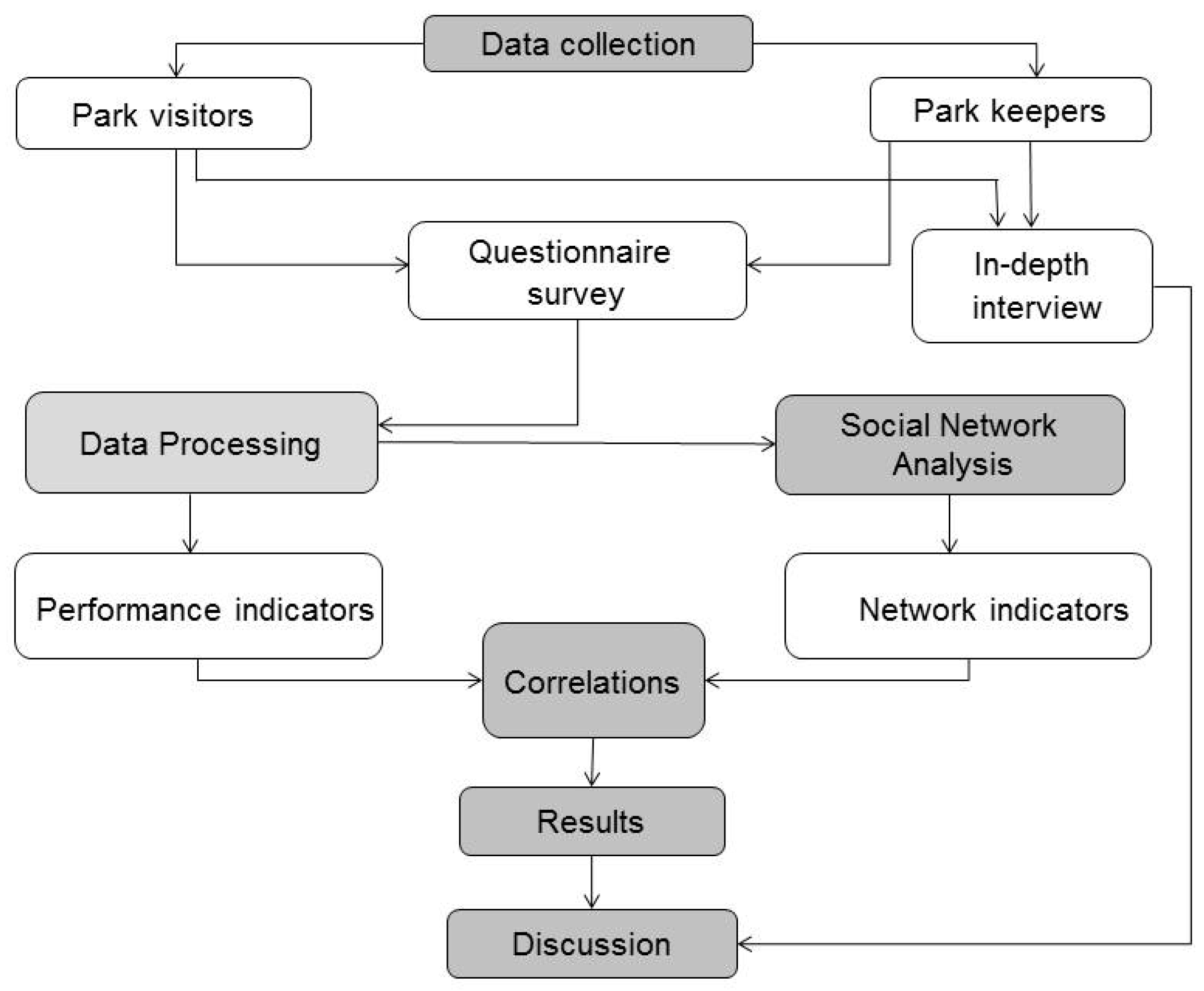
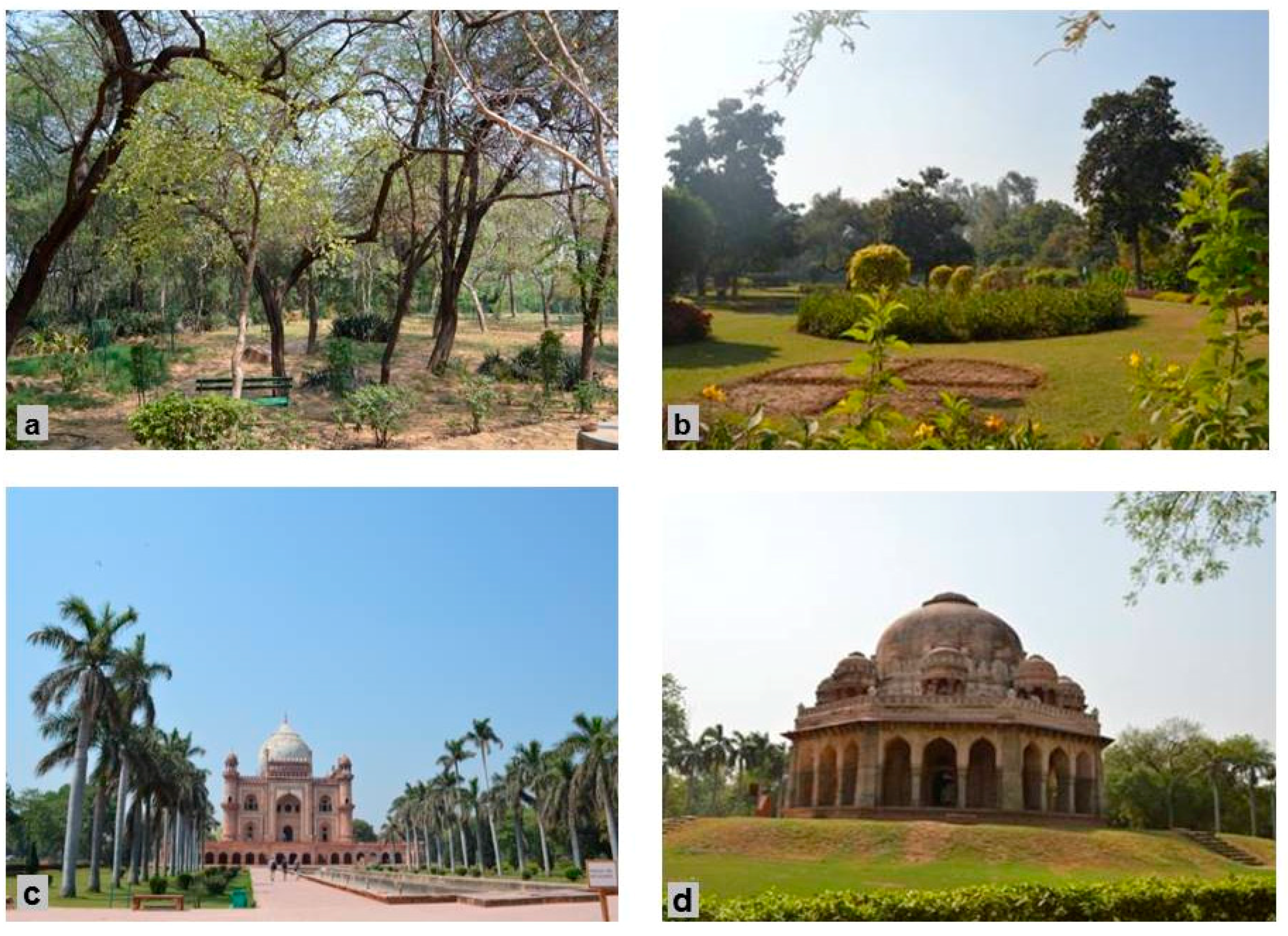
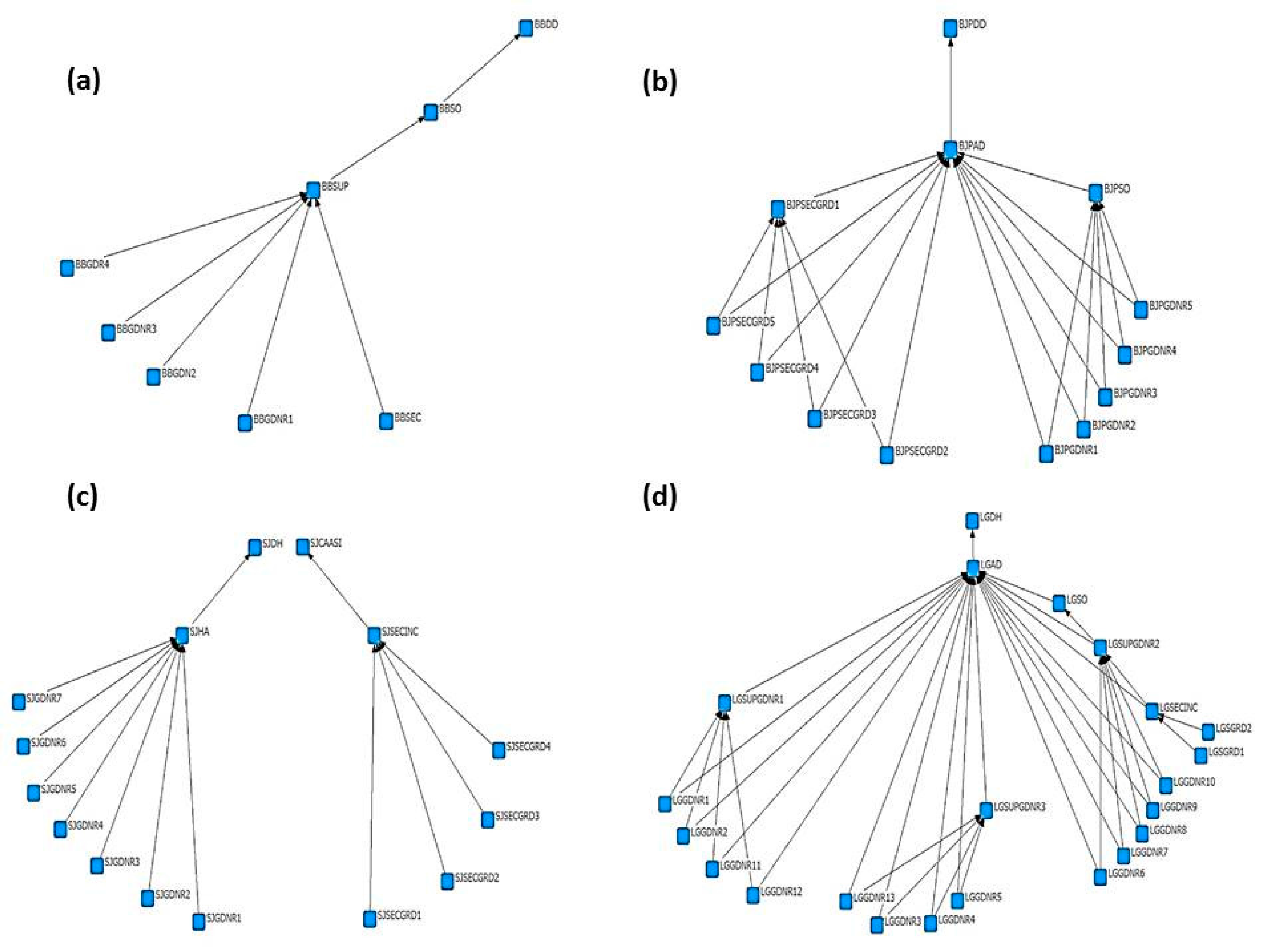
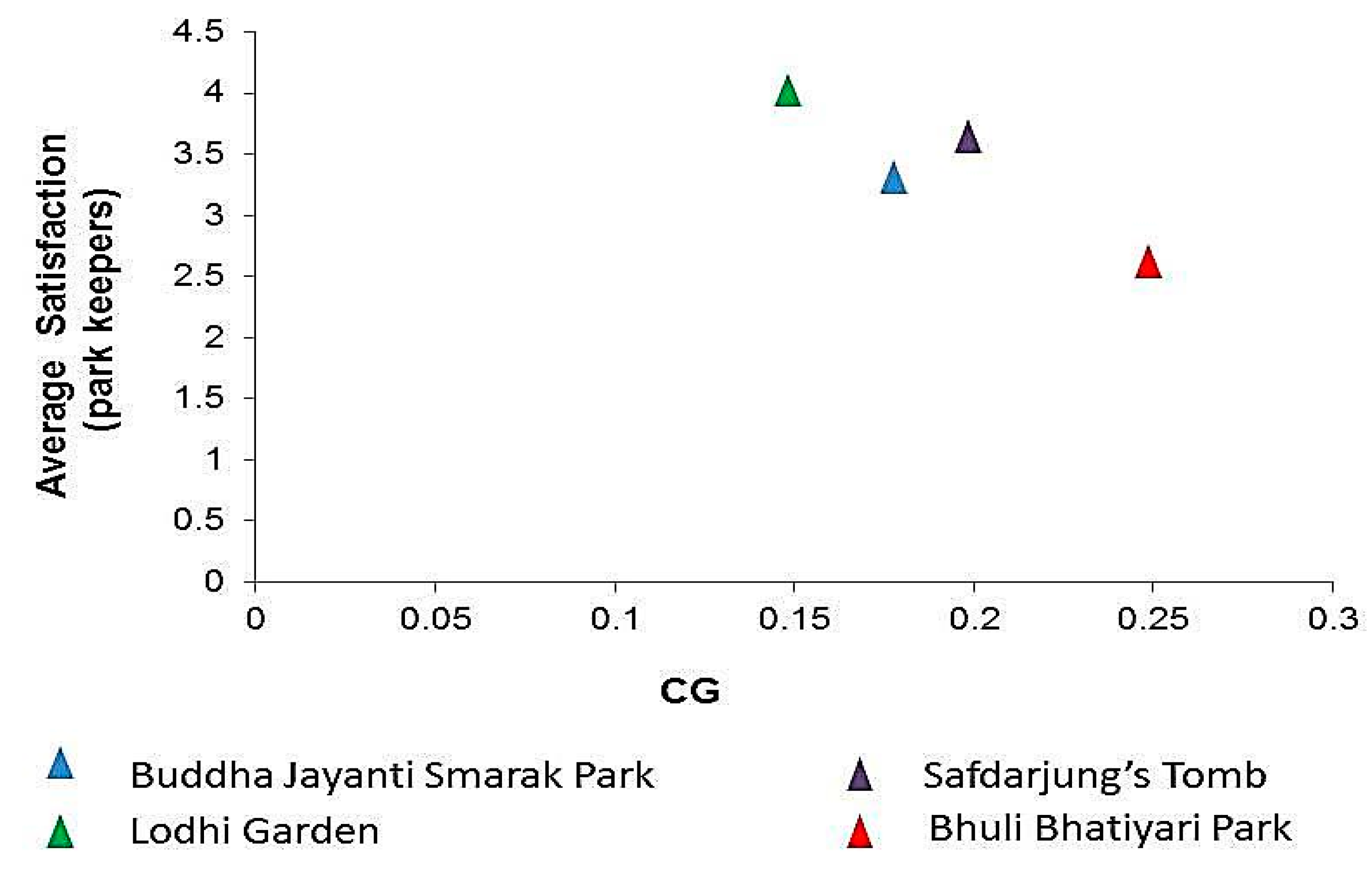
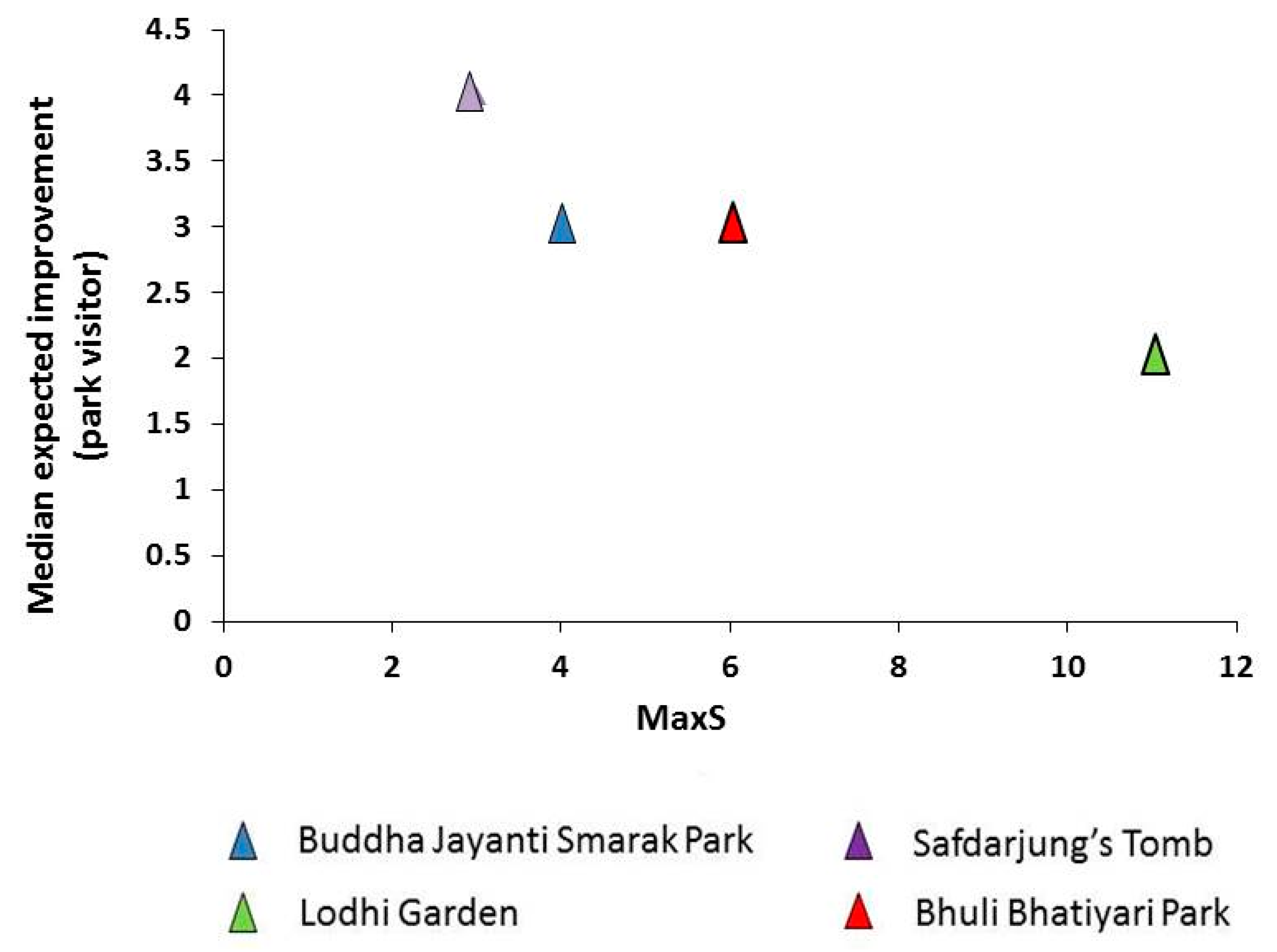
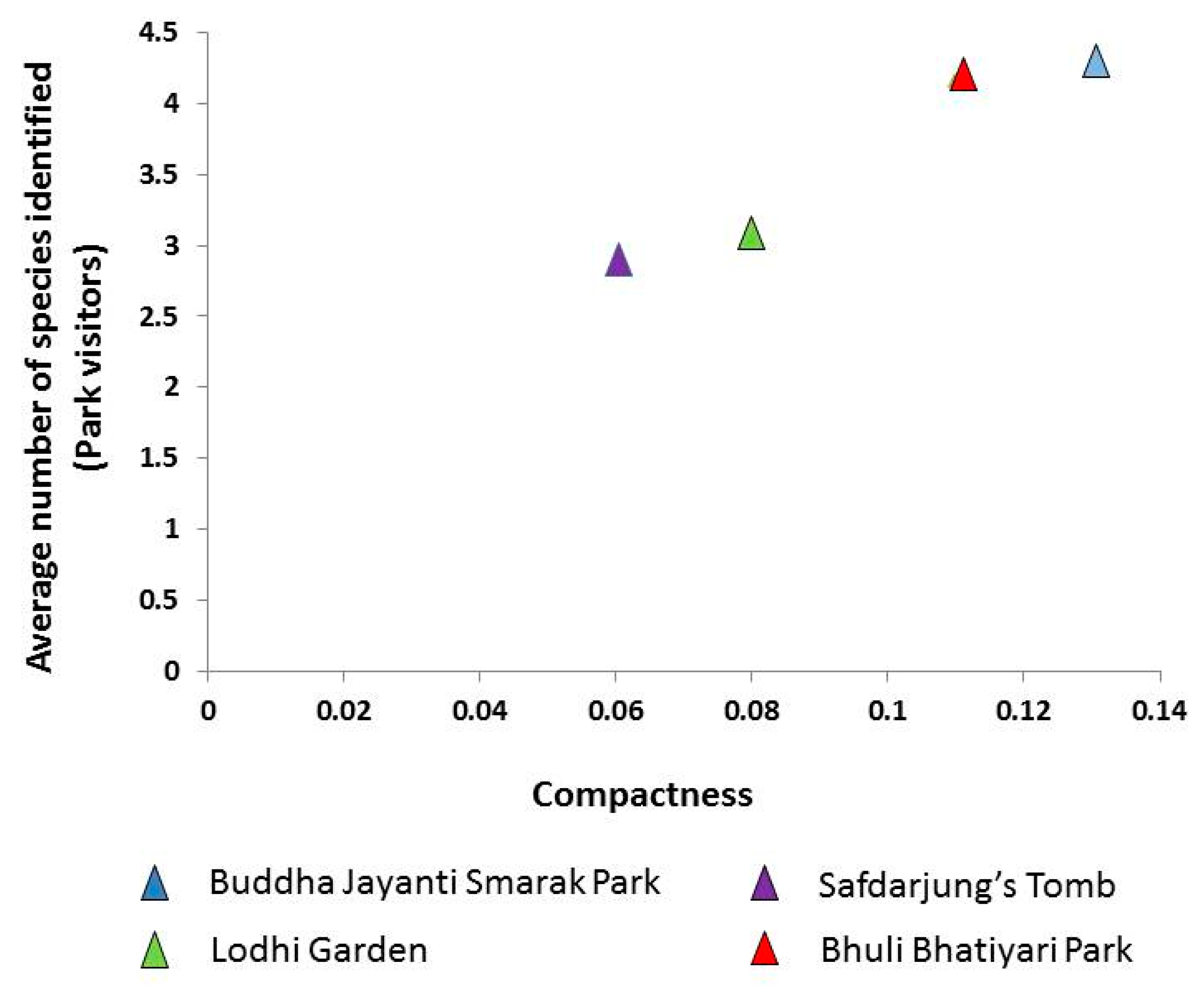
| Parks | Network Indices | ||||
|---|---|---|---|---|---|
| Nodes | Links | CG | MaxS | Compactness | |
| BBP | 8 | 7 | 0.25 | 6 | 0.11 |
| BJSP | 13 | 21 | 0.18 | 4 | 0.13 |
| ST | 15 | 13 | 0.2 | 3 | 0.06 |
| LG | 22 | 36 | 0.15 | 11 | 0.08 |
| Parks | Park Keepers | Park Visitors | ||
|---|---|---|---|---|
| Average Satisfaction | Median Problems | Median Expected Improvements | Average Number of Species Identified | |
| BBP | 2.57 | 3 | 3 | 4.16 |
| BJSP | 3.25 | 2 | 3 | 4.27 |
| ST | 3.62 | 2 | 4 | 2.84 |
| LG | 4 | 2 | 2 | 3.03 |
| p value (ANOVA) | <0.0001 * | 0.40 | <0.001 * | 0.04 |
| Network Indices | Performance Indicators | R2 Value | p Value | |
|---|---|---|---|---|
| CG | Park keepers | Average satisfaction | 0.81 | 0.04 * |
| Median problems | 0.76 | 0.06 | ||
| Park visitors | Median expected improvement | 0.23 | 025 | |
| Average number of species identified | 0.20 | 0.27 | ||
| MaxS | Park keepers | Average satisfaction | 0.16 | 0.29 |
| Median problems | 0 | 0.50 | ||
| Park visitors | Median expected improvement | 0.84 | 0.04 * | |
| Average number of species identified | 0.05 | 0.29 | ||
| Compactness | Park keepers | Average satisfaction | 0.36 | 0.05 |
| Median problems | 0.10 | 0.33 | ||
| Park visitors | Median expected improvement | 0.35 | 0.20 | |
| Average number of species identified | 0.93 | 0.02 * | ||
© 2017 by the authors. Licensee MDPI, Basel, Switzerland. This article is an open access article distributed under the terms and conditions of the Creative Commons Attribution (CC BY) license (http://creativecommons.org/licenses/by/4.0/).
Share and Cite
Paul, S.; Jordán, F.; Nagendra, H. Communication Networks and Performance of Four New Delhi City Parks. Sustainability 2017, 9, 1551. https://doi.org/10.3390/su9091551
Paul S, Jordán F, Nagendra H. Communication Networks and Performance of Four New Delhi City Parks. Sustainability. 2017; 9(9):1551. https://doi.org/10.3390/su9091551
Chicago/Turabian StylePaul, Somajita, Ferenc Jordán, and Harini Nagendra. 2017. "Communication Networks and Performance of Four New Delhi City Parks" Sustainability 9, no. 9: 1551. https://doi.org/10.3390/su9091551





